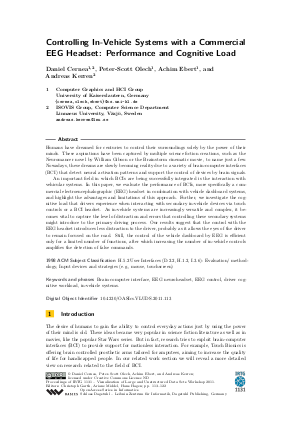Controlling In-Vehicle Systems with a Commercial EEG Headset: Performance and Cognitive Load
Authors Daniel Cernea, Peter-Scott Olech, Achim Ebert, Andreas Kerren
-
Part of:
Volume:
Visualization of Large and Unstructured Data Sets: Applications in Geospatial Planning, Modeling and Engineering - Proceedings of IRTG 1131 Workshop 2011 (VLUDS 2011)
Part of: Series: Open Access Series in Informatics (OASIcs) - License:
 Creative Commons Attribution-NoDerivs 3.0 Unported license
Creative Commons Attribution-NoDerivs 3.0 Unported license
- Publication Date: 2012-10-16
File

PDF
OASIcs.VLUDS.2011.113.pdf
- Filesize: 0.57 MB
- 10 pages
Document Identifiers
Subject Classification
Keywords
- Brain-computer interface
- EEG neuroheadset
- EEG control
- driver cog- nitive workload
- in-vehicle systems.
Metrics
- Access Statistics
-
Total Accesses (updated on a weekly basis)
0Document
0Metadata
Abstract
Humans have dreamed for centuries to control their surroundings solely by the power of their minds. These aspirations have been captured by multiple science fiction creations, such as the Neuromancer novel by William Gibson or the Brainstorm cinematic movie, to name just a few. Nowadays, these dreams are slowly becoming reality due to a variety of brain-computer interfaces (BCI) that detect neural activation patterns and support the control of devices by brain signals. An important field in which BCIs are being successfully integrated is the interaction with vehicular systems. In this paper, we evaluate the performance of BCIs, more specifically a commercial electroencephalographic (EEG) headset in combination with vehicle dashboard systems, and highlight the advantages and limitations of this approach. Further, we investigate the cognitive load that drivers experience when interacting with secondary in-vehicle devices via touch controls or a BCI headset. As in-vehicle systems are increasingly versatile and complex, it becomes vital to capture the level of distraction and errors that controlling these secondary systems might introduce to the primary driving process. Our results suggest that the control with the EEG headset introduces less distraction to the driver, probably as it allows the eyes of the driver to remain focused on the road. Still, the control of the vehicle dashboard by EEG is efficient only for a limited number of functions, after which increasing the number of in-vehicle controls amplifies the detection of false commands.
Cite As Get BibTex
Daniel Cernea, Peter-Scott Olech, Achim Ebert, and Andreas Kerren. Controlling In-Vehicle Systems with a Commercial EEG Headset: Performance and Cognitive Load. In Visualization of Large and Unstructured Data Sets: Applications in Geospatial Planning, Modeling and Engineering - Proceedings of IRTG 1131 Workshop 2011. Open Access Series in Informatics (OASIcs), Volume 27, pp. 113-122, Schloss Dagstuhl – Leibniz-Zentrum für Informatik (2012)
https://doi.org/10.4230/OASIcs.VLUDS.2011.113
BibTex
@InProceedings{cernea_et_al:OASIcs.VLUDS.2011.113,
author = {Cernea, Daniel and Olech, Peter-Scott and Ebert, Achim and Kerren, Andreas},
title = {{Controlling In-Vehicle Systems with a Commercial EEG Headset: Performance and Cognitive Load}},
booktitle = {Visualization of Large and Unstructured Data Sets: Applications in Geospatial Planning, Modeling and Engineering - Proceedings of IRTG 1131 Workshop 2011},
pages = {113--122},
series = {Open Access Series in Informatics (OASIcs)},
ISBN = {978-3-939897-46-0},
ISSN = {2190-6807},
year = {2012},
volume = {27},
editor = {Garth, Christoph and Middel, Ariane and Hagen, Hans},
publisher = {Schloss Dagstuhl -- Leibniz-Zentrum f{\"u}r Informatik},
address = {Dagstuhl, Germany},
URL = {https://drops.dagstuhl.de/entities/document/10.4230/OASIcs.VLUDS.2011.113},
URN = {urn:nbn:de:0030-drops-37459},
doi = {10.4230/OASIcs.VLUDS.2011.113},
annote = {Keywords: Brain-computer interface, EEG neuroheadset, EEG control, driver cog- nitive workload, in-vehicle systems.}
}
